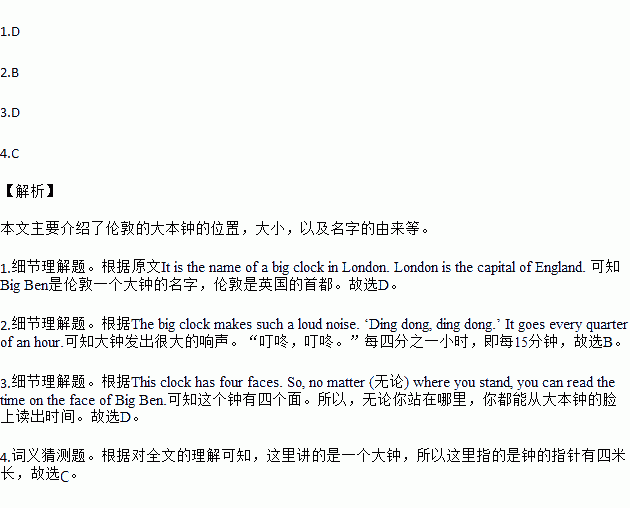题目内容
Big Ben is not the name of a man. It is the name of a big clock in London. London is the capital of England. This clock has four faces. So, no matter (无论) where you stand, you can read the time on the face of Big Ben. Each face is the size of a bus. The hands are about four meters long. It is about the size of two people standing on top of each other. If you go to London, you may want to visit the Houses of Parliament (国会大厦). In that place you will find Big Ben sits at the top of the clock tower in the Houses of Parliament. You will probably hear it and see it. The big clock makes such a loud noise. ‘Ding dong, ding dong.’ It goes every quarter of an hour. The name of Big Ben comes from a big builder.
1.Big Ben is in ____________.
A. China B. the USA C. Japan D. the UK
2.The clock strikes (敲) every ________ minutes of an hour
A. ten B. fifteen C. thirty D. forty-five
3.You can read the time of Big Ben ____________.
A. at the top of the clock tower B. in the Houses of Parliament
C. on the hands of the huge clock D. on the four faces of the clock
4.The underlined (划线部分) word ‘hands’ means ________ in Chinese.
A. 手 B. 标志 C. 指针 D. 发条
 字词句篇与同步作文达标系列答案
字词句篇与同步作文达标系列答案假如你是Tom, 请根据下表内容,给你的笔友Sandy写一封信介绍你家乡的情况。
要求:1.不要逐句翻译, 要包含表格中所有内容;
2.省略号部分适当发挥;
3. 80词左右(开头结尾不计入总字数)。
4.不得透露学校、姓名等任何个人信息,否则不予评分。
地理位置 | 芜湖北边;离芜湖市中心不远;开车大约50分钟 |
居住环境 | 空气清新;…… |
居民生活 | 公园散步;湖上划船 |
社会风尚 | 邻里和睦;…… |
交通出行 | 汽车、火车、私家车 |
感受 | ……(自拟1-2句) |
Dear Sandy,
Thank you for your letter. I am happy to tell you something about my hometown._______________________________________
All the best
Tom


